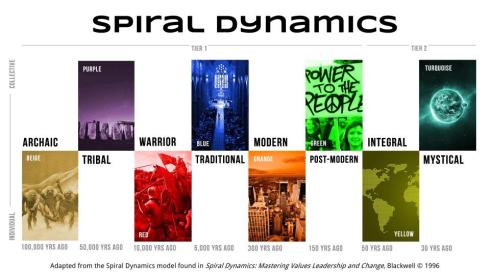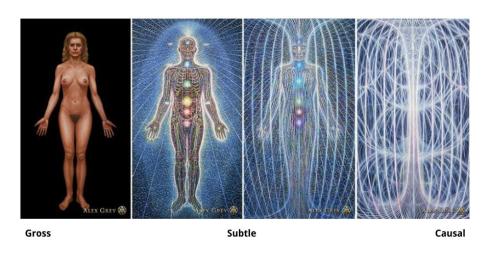Game of Thrones is a sprawling violent, bloody snapshot of a medieval fantasy world where different kingdoms and bloodlines struggle for control of the much-coveted “Iron Throne” — a seat in the capitol that rules all Seven Kingdoms of Westeros.
It’s also a detailed glimpse into a fictional world in spiritual transition — from ancestral nature religions to a mythical/numerological polytheism to an emerging (and much-contested) monotheism. If you watch Game of Thrones, you’ll notice that there is a lot of time spent explaining the religious motivations of the characters. It’s as if religion itself is a character in the story. The characters may offer “seven blessings” to their loved ones or curse their enemies to the “seven hells” — the number seven representing a set of archetypes based on social and spiritual virtues (Father, Mother, Warrior, Maiden, Smith, Crone, Stranger). At the same time, some characters are bent on appeasing the “one, true God” — the nascent and wrathful “Lord of Light” — through the blood and fire of human sacrifice.
Throughout the story, what the characters believe and how they interact with and interpret the actions of others begins to change based on what they begin to see with their own eyes. And to hear this kind of religion described, you might think that these forms of worship, these outdated modes of spiritual expression, so rooted in mythology and superstition, have long passed from our society. I can assure you, that in some corners of our planet, these types of nature-based and/or polytheistic religion (or variations of them) are still very much alive.
“Integral” Spirituality is part of a lineage that is woven through many teachers (Sri Aurobindo, Haridas Chaudhuri, Alan Watts, Ken Wilber, et. al.). And very recently, religion (or the interpretation of religious experience) that is rooted in post-modern and pluralistic structures has done much to synthesize some of our more sacred and socially held values that have long been viewed as opposites — ideas like east and west, science and spirituality, inner and outer, masculine and feminine, the individual and the collective, grasping and sitting — it is an emerging spirituality, not of either/or, but of both/and.
However, it’s not all rose-colored radical inclusivity. Implementing pluralism as its own practice, while avoiding the accusations and actual pitfalls of syncretism has proven to be difficult. Integral spirituality needs to honor the differences we find in the various religions and it does so not by comparing the human experience of gods and goddesses to the experience of blind men with an elephant, or minimizing the paths of tradition by winding them up the same mountain of “spiritual Oneness.” It succeeds by making a clear distinction between things like cultural history, creativity and mythology, human rights and freedoms, communities of practice, states of awareness, stages of consciousness, lines of development or intelligence, personality and gender types, and so on.
We will look at two of those here — stages and states — and hopefully gain a better understanding of how Integral spirituality allows us a deeper and more meaningful understanding of the relationship with our Self, with those around us and with the Divine, or Spirit-in-Action.
Stages of Consciousness
First we’ll look at stages of consciousness. These stages have been imagined as a vertical line (or nested hierarchy of circles).
This is how cultures have mapped the development or unfolding of our own worldview as we move from birth to death. These stages, according to Ken Wilber’s A Brief History of Everything, move us from egocentric (care and concern for the self) to ethnocentric (care and concern for the family or the community) to worldcentric (care and concern for all beings).
It’s best illustrated with something called Spiral Dynamics. Developed by Don Beck and Chris Cowan, this model proposes the idea that the consciousness of all beings (as well as all societies or groups) unfolds in a spiral that oscillates between self-interest and concern for the group, and is continually expanding while incrementally including more and more perspectives.
| VALUES SYSTEM | COLOR | DESCRIPTION |
| Archaic | Beige | Primal, instinctive, survivalistic. Food, warmth, sex and safety.
Origin: 100,000 years ago. |
| Tribal | Purple | Loyalty to the tribe, magical/animistic beliefs, family rituals and blood oaths. Observe customs and cycles. Sacrifice is made for the tribe.
Origin: 50,000 years ago. |
| Warrior | Red | Impulsive/egocentric beliefs, self-interest, self-expression, only the strong survive, domination and rebellion, kingdoms and heroes (negatives: gangs, the “terrible twos”). Creates change through the use of power.
Origin: 10,000 years ago. |
| Traditional | Blue | Authoritarian beliefs, law and order, good and evil polarized, mythic/literal interpretations, ethnocentric, “my country right or wrong.” (positives: ordered meaningful existence, absolute truth, rightful living). Sacrifice is made for truth.
Origin: 5,000 years ago. |
| Modern | Orange | Self-reliance, rational/scientific worldview, achieveist/strategic beliefs, “life is a game,” risk-taking. (positive: the Enlightenment, industrial revolution, negative: capitalist exploitation, environmental devastation, mechanistic view of life/the universe). Creates change through manipulation.
Origin: 300 years ago. |
| Post-modern | Green | Communitarian/egalitarian, worldcentric, social justice, world peace, deep ecology, human rights, religious pluralism, multiculturalism, communes. (positive: birth of the internet, negative: hatred of hierarchies, disdain for competition). Sacrifice is made for consensus.
Origin: 150 years ago. |
| Integral | Yellow | Integrative, enlightened self-interest; flexibility, functionality and responsibility; all value systems are valid, holarchies, value-based hierarchies (good, beautiful, true), systems thinking, “Third Way” politics. Creates change using knowledge.
Origin: 50 years ago. |
| Mystical | Turquoise | Holistic worldview, a balanced system of interlocking forces, body/mind/spirit approaches to experience, global networks/global solutions. Identifies with collective mind or unified, evolving whole. Sacrifice is made for the planet/all beings.
Origin: 30 years ago. |
States of Awareness
States of awareness are simply the layers of what we call the “self” or the “body.” They have been taught by the world’s faith traditions to be viewed as concentric circles or sheaths (i.e. the koshas) that begin with the physical body and expand (or deepen) to include more energy (i.e. prana), more matter, more Spirit.
- Gross Body – Sensory awareness, waking state
- Subtle Body – Extra-sensory awareness, energetic body (Qi, shen, prana), dreaming or altered states
- Causal Body – Formless awareness, the Soul, the Overmind
- “State that is all states” – Non-dual awareness, Turiya, Divine Milieu, Spirit, Atman
The thing to be aware of here is that someone can be at the highest peak state experience — blissed-out, in a state of rapture — yet themselves be at a Traditional (ethnocentric) stage, a blue value system or lower. And the opposite is also true (higher value systems, and a lower or more narrow energetic body). An example might be the “enlightened” Zen master (inhabiting higher states of awareness) with a highly-developed line of morality and ethics, who is generous and humble, yet who holds strong cultural biases — racist or homophobic beliefs. Continue reading







